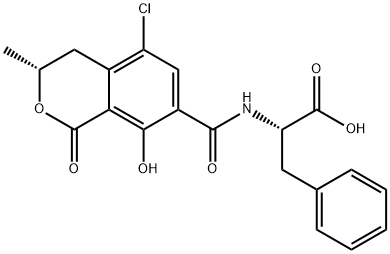Chemical Properties
White crystalline solid or powder.
Chemical Properties
white to off-white crystalline powder
Uses
Ochratoxin A is a chlorinated benzopyran coupled to phenylalanine, produced by several Aspergillus and Penicillium sp. associated with food spoilage. Ochratoxins are widely distributed in the environment and are known to be nephrotoxic, teratogenic and possibly carcinogenic. Ochratoxin A may act by inducing DNA strand breaks, sister chromatid exchanges, DNA adduct formation, or reactive oxygen but the mechanism of action as a toxin is not yet resolved. At the molecular level, ochratoxin A specifically inhibits NK cell activity, increases growth of transplantable tumour cells in mice, increases apoptosis, activates c-Jun N terminal kinase in human kidney epithelial cells, and blocks metaphase/anaphase transition. It also inhibits plasminogen activator inhibitor-2 production by human blood mononuclear cells.
Uses
Ochratoxins are toxic metabolites from Aspergillus orchraceus.
Uses
A nephrotoxic mycotoxin inhibitor of phenylalanyl-tRNA synthetases.
Definition
ChEBI: A phenylalanine derivative resulting from the formal condensation of the amino group of L-phenylalanine with the carboxy group of (3R)-5-chloro-8-hydroxy-3-methyl-1-oxo-3,4-dihydro-1H-2-benzopyran-7-carb
xylic acid. It is among the most widely occurring food-contaminating mycotoxins, produced by Aspergillus ochraceus, Aspergillus carbonarius and Penicillium verrucosum.
General Description
White crystalline powder.
Air & Water Reactions
Insoluble in water.
Reactivity Profile
OCHRATOXIN A is incompatible with strong oxidizing agents, strong acids and strong bases. . OCHRATOXIN A is a carboxylic acid derivative. Carboxylic acids donate hydrogen ions if a base is present to accept them. They react in this way with all bases, both organic (for example, the amines) and inorganic. Their reactions with bases, called "neutralizations", are accompanied by the evolution of substantial amounts of heat. Neutralization between an acid and a base produces water plus a salt.
Hazard
Hepatotoxic, nephrotoxic, extremely toxic;
possible carcinogen.
Fire Hazard
Flash point data for OCHRATOXIN A are not available; however, OCHRATOXIN A is probably combustible.
Biological Activity
Mycotoxin that increases activity of the endoplasmic reticulum ATP-dependent calcium pump. Induces JNK activation and apoptosis in MDCK-C7 cells at nanomolar concentrations. Stimulates lipid peroxidation.
Safety Profile
Confirmed carcinogen
with carcinogenic and neoplastigenic data.
Poison by ingestion, intraperitoneal,
intravenous, and subcutaneous routes. Experimental teratogenic and reproductive
effects. Mutation data reported. When
heated to decomposition it emits very toxic
fumes of Cland NOx.
Potential Exposure
Ochratoxin A, a carboxylic acid derivative
and a naturally occurring toxic mold (strain of
Aspergillus ochraceus), occasionally in storage grains such
as wheat and on field crops such as corn and oilseed (i.e.,
cottonseed), in ancient tombs, and decayed vegetation.
Used as a laboratory chemical for research. Not currently
produced in the United States.
Carcinogenicity
Ochratoxin A is reasonably anticipated to be a human carcinogen based on sufficient evidence of carcinogenicity from studies in experimental animals.
Shipping
UN2811 Toxic solids, organic, n.o.s., Hazard
Class: 6.1; Labels: 6.1-Poisonous materials, Technical Name
Required. UN3462 Toxins, extracted from living sources,
solid, n.o.s., Hazard Class: 6.1; Labels: 6.1-Poisonous materials,
Technical Name Required.
Incompatibilities
Ochratoxin A is Incompatible with oxidizers
(chlorates, nitrates, peroxides, permanganates, perchlorates,
chlorine, bromine, fluorine, etc.); contact may cause
fire. Keep away from alkaline materials, strong bases,
strong acids, oxoacids, and epoxides. Compounds of the
carboxyl group R.COOH Compounds of the carboxyl
group react with all bases, both inorganic and organic (i.e.,amines) releasing substantial heat, water, and a salt that
may be harmful. Incompatible with arsenic compounds
(releases hydrogen cyanide gas), diazo compounds, dithiocarbamates,
isocyanates, mercaptans, nitrides, and sulfides
(releasing heat, toxic, and possibly flammable gases),
thiosulfates and dithionites (releasing hydrogen sulfate
and oxides of sulfur).
Waste Disposal
Consult with environmental
regulatory agencies for guidance on acceptable disposal
practices. Generators of waste containing this contaminant
(≥100 kg/mo) must conform with EPA regulations governing
storage, transportation, treatment, and waste disposal.
Under 40 CFR 261.5 small quantity generators of this
waste may qualify for partial exclusion from hazardous
waste regulations.


